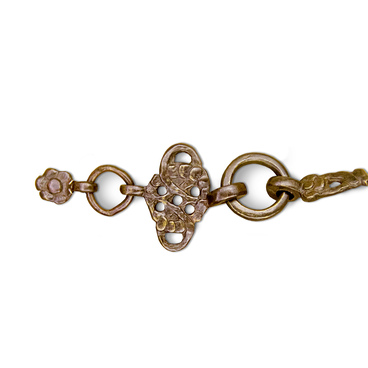Archaeologists established that the Volga Bulgars' jewelry making reached a high level. This is confirmed by the tools of the craftsmen and numerous items found during the excavations.
On the territory of the once large urban centers, experts discovered a variety of molds for the manufacture of women’s jewelry and belt sets, metal stamping dies and anvils for embossing, and also chasing hammers and bronze tweezers.
For women, craftsmen made plate and twisted bracelets, rings, moon-shaped earrings, and temple pendants of silver or gold. For men, jewelry was cast for belts, ceremonial horse harnesses. Jewelers from Volga Bulgaria mastered complex methods of processing precious metals. For example, they decorated products with the finest threads and tiny balls using filigree technique or decorated them with filigree — they soldered a drawing from a thin twisted cord. The filigree was made of gold or silver. Bolgars pulled a thin gold thread by hand using a special steel plate with round holes. Such products were made by the craftsmen by order of the highest nobility or their closest circle.
Bulgars made not only skillful original jewelry, but also their cheaper counterparts for less wealthy customers. In this case, instead of complex filigree work and granulation, casting molds were used that imitate this texture. This technology was called “hollow casting”. First, the molten metal was poured into a mold, and after a while, it was poured out of it. A thin layer of cooled material repeated the given geometry.
The belt mordant from the collection of the Bolgar Museum-Reserve was made using the technique of simple mold casting. It is decorated with a carved image of a fantastic animal with the head and neck of a dragon, small wings, as well as the paws and tail of a lion. Such a mordant was attached to the belt using four cylindrical rods. The belt set also consisted of a buckle with a frame and a prong, decorative plates, and a ring on which a scabbard strap was hung.
On the territory of the once large urban centers, experts discovered a variety of molds for the manufacture of women’s jewelry and belt sets, metal stamping dies and anvils for embossing, and also chasing hammers and bronze tweezers.
For women, craftsmen made plate and twisted bracelets, rings, moon-shaped earrings, and temple pendants of silver or gold. For men, jewelry was cast for belts, ceremonial horse harnesses. Jewelers from Volga Bulgaria mastered complex methods of processing precious metals. For example, they decorated products with the finest threads and tiny balls using filigree technique or decorated them with filigree — they soldered a drawing from a thin twisted cord. The filigree was made of gold or silver. Bolgars pulled a thin gold thread by hand using a special steel plate with round holes. Such products were made by the craftsmen by order of the highest nobility or their closest circle.
Bulgars made not only skillful original jewelry, but also their cheaper counterparts for less wealthy customers. In this case, instead of complex filigree work and granulation, casting molds were used that imitate this texture. This technology was called “hollow casting”. First, the molten metal was poured into a mold, and after a while, it was poured out of it. A thin layer of cooled material repeated the given geometry.
The belt mordant from the collection of the Bolgar Museum-Reserve was made using the technique of simple mold casting. It is decorated with a carved image of a fantastic animal with the head and neck of a dragon, small wings, as well as the paws and tail of a lion. Such a mordant was attached to the belt using four cylindrical rods. The belt set also consisted of a buckle with a frame and a prong, decorative plates, and a ring on which a scabbard strap was hung.

